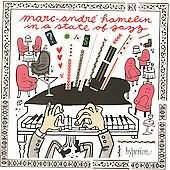What an imaginative program Marc-André Hamelin has assembled: jazz-inspired works that are virtuosic like nobody’s business and totally fun to listen to. Certainly the pianist makes George Antheil’s tiny Jazz Sonata sound easy (few can) while sustaining its boisterous profile. The genial contrapuntal wit characterizing Friedrich Gulda’s Exercises and the Prelude and Fugue easily could be mistaken for early Dave Brubeck. Alexis Weissenberg’s ambitious Sonate en état de jazz often channels Gershwin, Ravel, and Jobim in heated conversation, fending off dissonances. Hamelin’s supple shaping of the Tango and Samba movements benefits from faster tempos than those on Simon Mulligan’s Nimbus recording, although Mulligan’s brooding, protracted nine-and-a-half-minute Blues movement holds equal attention alongside Hamelin’s more serene, less angst-ridden five-minute-fourteen-second rendition.
Weissenberg’s Charles Trenet arrangements (recorded by the pianist under an assumed name, and subsequently transcribed by Hamelin) achieve a natural, scintillating pop/classical fusion that yields nothing to the finest work of Peter Nero and Don Shirley.
Collectors familiar with Steven Osborne’s Hyperion recording of the Kapustin Second Sonata may be curious as to how Hamelin’s interpretation compares. Technically, of course, Hamelin is beyond reproach. He articulates the Scherzo’s leaping chords and the Finale’s lighting-fast runs with whiplash clarity, laser-like focus, and extraordinary evenness. Yet Osborne is no slouch, and I find his sharper accentuation, wider dynamic scope, and overall phrasing more idiomatic jazz-wise.
Although his first-movement tempo does not come close to the Allegro molto Kapustin requests and Hamelin decisively delivers, Osborne proves more attuned to the music’s harmonic richness. He captures the loping behind-the-beat, Erroll Garner-like left-hand chords to more swinging effect here and in the Scherzo’s trio. Similarly, in the Largo, Osborne’s stronger melodic projection and clearer distinctions between foreground and background material contrast to Hamelin’s gorgeously limpid, less intense demeanor. In the final analysis, Hamelin may not represent the last word in swing, but he’s a serious contender for the first word in piano playing.
































